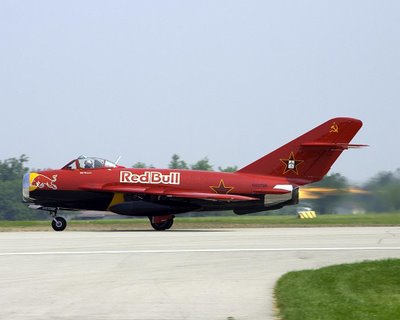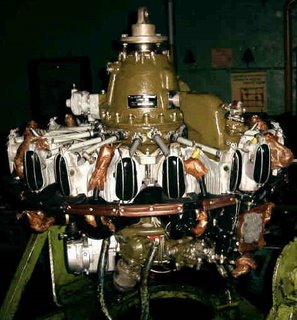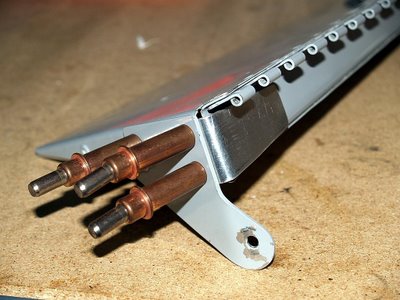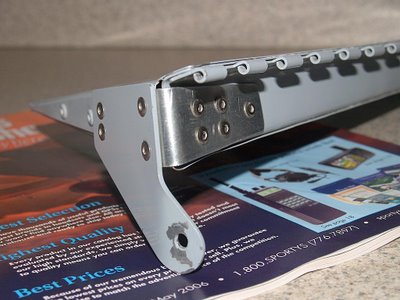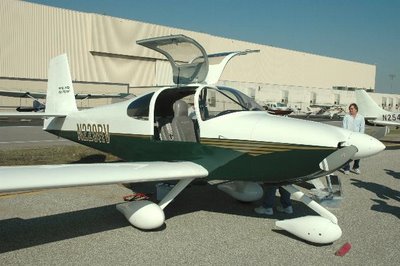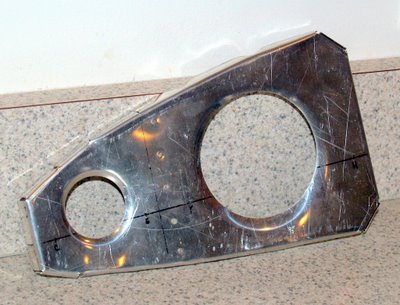The weather this morning was pretty good for a first flight after the annual. The forecast called for winds at 8 knots all day, but a possible layer of scattered clouds at 5,000'. Good enough.
Even though I ran up the engine to check for leaks just a few days ago, and both my A&P and I have both looked over everything on the plane, I approach the first flight after an annual with a higher degree of pessimism than usual for a more routine flight. On take-off, for example, I make a steeper than normal climb, clawing for a few extra feet of altitude to have in the bank in case something goes wrong with the engine. And as the winds were out of the north today, I'd be using runway 4. Runway 4 is a bit more congested on the departure end than 22 is, so just after takeoff I'm faced with a Lowe's, a string of restaurants, condos, and car dealerships. I try to get to 1,000' as quickly as I can and get myself turned towards the west where there's still a lot of open land.
My first flight after annual is nearly always to MadCo. It's only 20 miles away, so if any problems become apparent after takeoff I'll be close to at least one airport. Darby Dan is out there too, and there's a nice grass runway 2.5 miles west, so there are plenty of options should I need to land quickly. The annual trip to MadCo is just long enough for anything that's going to work itself loose gets a good start and makes itself easier to find. This was particularly true with the Tampico. It seemed to be impossible to get the bottom cowl screws tight enough to keep them from backing out. By the time I landed at MadCo, 3 or 4 would have started their escape, so I always brought a screwdriver with me, and in fact ended up keeping a screwdriver in the plane all the time.
This time, though, I didn't find anything loose at all. I paid extra attention to the trim tab but it hung on just fine. There was a little more oil on the belly than usual, but that's normal after an oil change. It's a challenge to complete an oil change without spilling at least a little oil, and I use 7 quarts when I replace the oil and some of that vents out in flight until the oil level gets down to 6 or so quarts. From there it remains steady until the next oil change. Had I had a belly dripping with oil today, I would have had to get the cowls off and try to find out where the leak was coming from.
After gassing up at $3.79/gal. (GASP!) I headed east towards Lancaster Fairfield Co, where they were having an EAA open house and fly-in pancake breakfast. I had already breakfasted on scrapple (do yourself two favors: try scrapple, but don't EVER read the ingredients) so the pancakes had no appeal, but Lancaster is where Papa Golf used to live. I haven't gone in there in the 6 yet, so I thought it would be a neat time to have a little homecoming.
On the way from MadCo to Lancaster, I had a great view of my Central-Ohio neighborhood and my home field neighborhood:
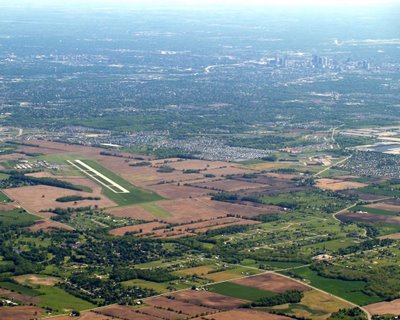
The ride over was bumpy below 5,500' but really smooth above that. I monitored the radio most of the way there, trying to gauge the traffic level. One of the problems with fly-ins is that a lot of people fly in to them, so the traffic can sometimes be fairly heavy. It didn't sound very busy, but I noted a recurring helicopter departure (I assume they were selling sightseeing rides) heading to the south and returning a few minutes later heading north, and then landing directly onto the ramp. I'd have to keep track of him since I'd be passing directly south of the airport when I flew left downwind to runway 28. I figured I might also encounter some NORDOs (no radios) since an antique aircraft group was supposed to attend, and a lot of those older planes don't have electrical systems. Most will carry a battery operated hand held radio, but you never know, so it's best to really be on the lookout for them.
These guys stopped by:

I turned final with a Cessna right behind me, and since I can be a bit slow on the roll out, I try to get off the runway as soon as I can. Sometimes that means landing long if the first taxiway is pretty far down the runway, or it could mean landing short if there is a taxiway within a few hundred feet of the end of the runway. Lancaster is configured such that the first available taxiway called for a short landing, which went well enough considering the almost hypnotic waviness of the runway. Unfortunately, my plan went awry when I was faced with two planes taxiing out for takeoff. It would have been better to land long and take the middle taxiway after all. In any event, when noting the intimidating visage of a military marked taildragger, the other two pulled aside to let me pass. Thanks Flaps! And it's always nice to see Dogg and his Purty-8.
I taxied in and was parked by a friendly EAA volunteer right next to the RV-4 being flown by a very prolific build named Rick. Rick is a large part of my inspiration to build myself an airplane, but he's a bad influence on me when it comes to deciding between the F1-Rocket or RV-14 (RV-10 + RV-4 = RV-14). His decision was "all 3," at least temporarily. Rick took co-pilot Egg for her first ride in an RV, and therefore became instrumental in my getting my 6. She was hooked after the first flight, as is just about anybody that rides in one. It's very, very contagious, often being transmitted by simple ocular contact with printed likenesses. With her blessing, I was finally able to sever the last emotional bond to the Tampico.
We wandered around a bit and looked at the other RVs, but the one thing I really wanted to do was take a look inside one of the hangars. I noticed it when I was driving down there to look at Papa Golf, and it looked like it might be a museum of sorts. And as it turns out, it is. They have a B-25 and an A-26, two WWII medium bombers, although I think the A-26 may have had a ground support role as well. I'd have to look that up to refresh my memory.
They'll restore this helicopter eventually:
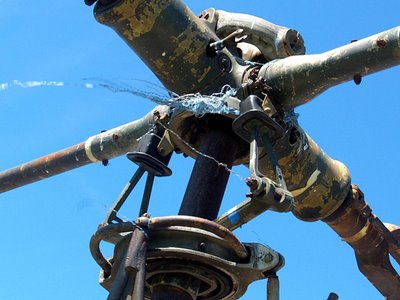
The RV-4 is still pretty new to Rick, so he asked if I could get a few air-to-air pictures for him. I had the SLR with me, so the only remaining concern I had was just how close he'd have to get to me since I only had the short lens. Rick does a lot of formation flying and has flown on the wing of newbies before, so I wasn't concerned that he'd run into me, but I wanted to know what to expect so I wouldn't make the ride too rough on him by making abrupt control inputs. The closer he got, the smoother I needed to be. We briefed a turn to the south and a climb to 5,000m which would get us out into the sparsely inhabited Hocking Hills area and get us up into the smoother air.
I like this one because it has part of my wing in it, but I have a few with just Rick in the frame too:

The 8 megapixel camera lets me crop quite aggressively, so other than its diffcult-to-frame aspect ratio, this picture would still have a high enough resolution to get a good sized print:

If you can settle for a snapshot sized print, you can get really,
really aggressive with the cropping:
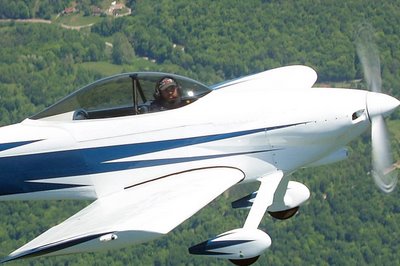
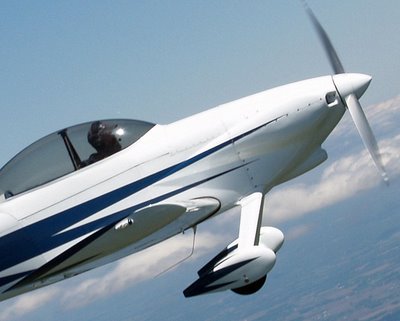
Things went fine with the flying, but watching Rick pull away from me while I was at full power reminded me that I need to get busy and replace the fairings and wheel pants. The old ones aren't even on the plane anymore until I patch up the screw holes - they got pretty worn out last summer when I was learning to land. That's costing me 10 mph or so, and with gas at almost $4 a gallon, I think a case can be made for investing in newer, more efficient fairings. Plus they will get fit, trimmed, sanded and painted without grounding the airplane, so I won't miss out on any of the flying season.
I'll have to replace the support brackets which may or may not involve jacking the plane and possibly removing a wheel, but that doesn't take long. I'll be done with school for the summer after Memorial Day so I'll have some time to work on it. I'll dig out my notes and see what I had decided on before. I think it was Team Rocket fairings and Van's wheel pants, but I'll want to confirm that before tossing out the $$$s.
As to landings, MadCo was not too good, a couple of little bounces. Lancaster was ok, but there was a little scuffing of tires until I could get the flaps up and get slowed down a bit. It was getting windier by the time I got there, so I carried a few extra mph on approach and paid for it by being too fast in the flare. Still, got stopped in time to impede Flaps and Dogg on their way to the runway. Back at Bolton, the winds had picked up to 15 gusting 20, a level that would have kept me at home if I had seen it forecast. It was only from 40 degrees left of the runway heading, though, so the sideways component would be much lower. The frontal component messes with me in the flare if it's gusty, though, so I couldn't just ignore it. Again, I held a few extra knots and extended my landing further down the runway (to avoid the long taxi back to the hangar from 4) but this time it was a complete greaser. I got a foot or so drift from the crosswind as the tires were just spinning up on the runway, but it was glass from there.
Back in the hangar and all of the parts are still on the plane, and there's no increase in the oil on the belly. I'll probably clean that off tomorrow since it seems to have finished it's purging.
So, my quick test flight went a bit long, but it was another beautiful day to have a plane, which makes it an extraordinary day to own an RV!
